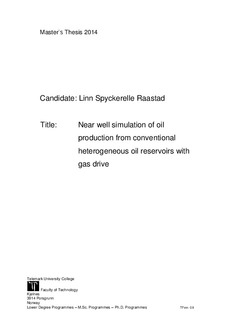| dc.contributor.author | Raastad, Linn Spyckerelle | |
| dc.date.accessioned | 2015-10-30T14:25:49Z | |
| dc.date.accessioned | 2017-04-19T13:18:11Z | |
| dc.date.available | 2015-10-30T14:25:49Z | |
| dc.date.available | 2017-04-19T13:18:11Z | |
| dc.date.issued | 2015-10-30 | |
| dc.identifier.citation | Raastad, L:S. Near well simulation of oil production from conventional heterogeneous oil. Master thesis, Telemark University College, 2014 | |
| dc.identifier.uri | http://hdl.handle.net/11250/2439040 | |
| dc.description.abstract | Drilling horizontal wells has been provided to be useful for producing oil and gas. This meant increased production by maximizing the reservoir contact. However, due to heel-toe effect an uneven influx of reservoir fluid to the wellbore is a challenge. This may resulting in early gas breakthrough and uneven inflow down coming. These conditions can limit sweep efficiency and reduce hydrocarbon recovery. One good example of conventional heterogeneous oil reservoir with gas drive is the Troll field. This is a large gas field with relative thin oil zone. Inflow control technology was developed and introduced during the recent years to overcome some of these challenges. Inflow control device ( ICD's) have improved well performance compared to conventional wells. For high-rate horizontal wells in thin oil rim reservoirs this solutions are especially attractive. The objective of this thesis was to evaluated horizontal well performance in a heterogeneous conventional oil reservoir with open hole and ICD's completion for two phase flow oil and gas. Simulations were performed by using OLGA coupling with Rocx as the simulating tools. Tecplot was used to present oil and gas saturation profiles in YZ direction in the reservoir. One of the goal in the thesis was to simulate with data's from a real felt with conventional oil production and comparing the results. All data's are provided in tables in the thesis, were the Troll field is in detailed described. The simulations data's are taken from earlier testing/simulations from well Q-12BH that are located on Troll field. The goal was to simulate both the open completion and ICD's completion until gas breakthrough occurred. For comparative purpose the same input criteria in Rocx were used in all cases. After approximately 45 days of production in the open hole simulations, gas started to drained into the production well. The production flow rate was about 5000 m3/day and after 57 days of production gas breakthrough takes place. Simulation with ICD's was also performed and in order to compare the effect of the ICD's, different restriction were tested in three different cases. Conventional oil production with ICD completion was about 1700, 1500 and 1300 m3/day in the three different cases. Based on the simulations result it seems that most evenly distributed restriction is to be preferred over time regarding to total oil production. Gas breakthrough did not take place after 57 days as in the open hole simulations. This verifying that wells with ICD's are more effective when it comes to total oil production and preventing gas breakthrough. | |
| dc.language.iso | eng | |
| dc.publisher | Høgskolen i Telemark | |
| dc.subject | OLGA-Rocx simulation | |
| dc.subject | Horizontal reservoir | |
| dc.subject | Oil production | |
| dc.subject | Gas breakthrough | |
| dc.title | Near well simulation of oil production from conventional heterogeneous oil | |
| dc.type | Master thesis | no |
| dc.description.version | Published version | |
| dc.rights.holder | © Copyright The Author. All rights reserved | |
